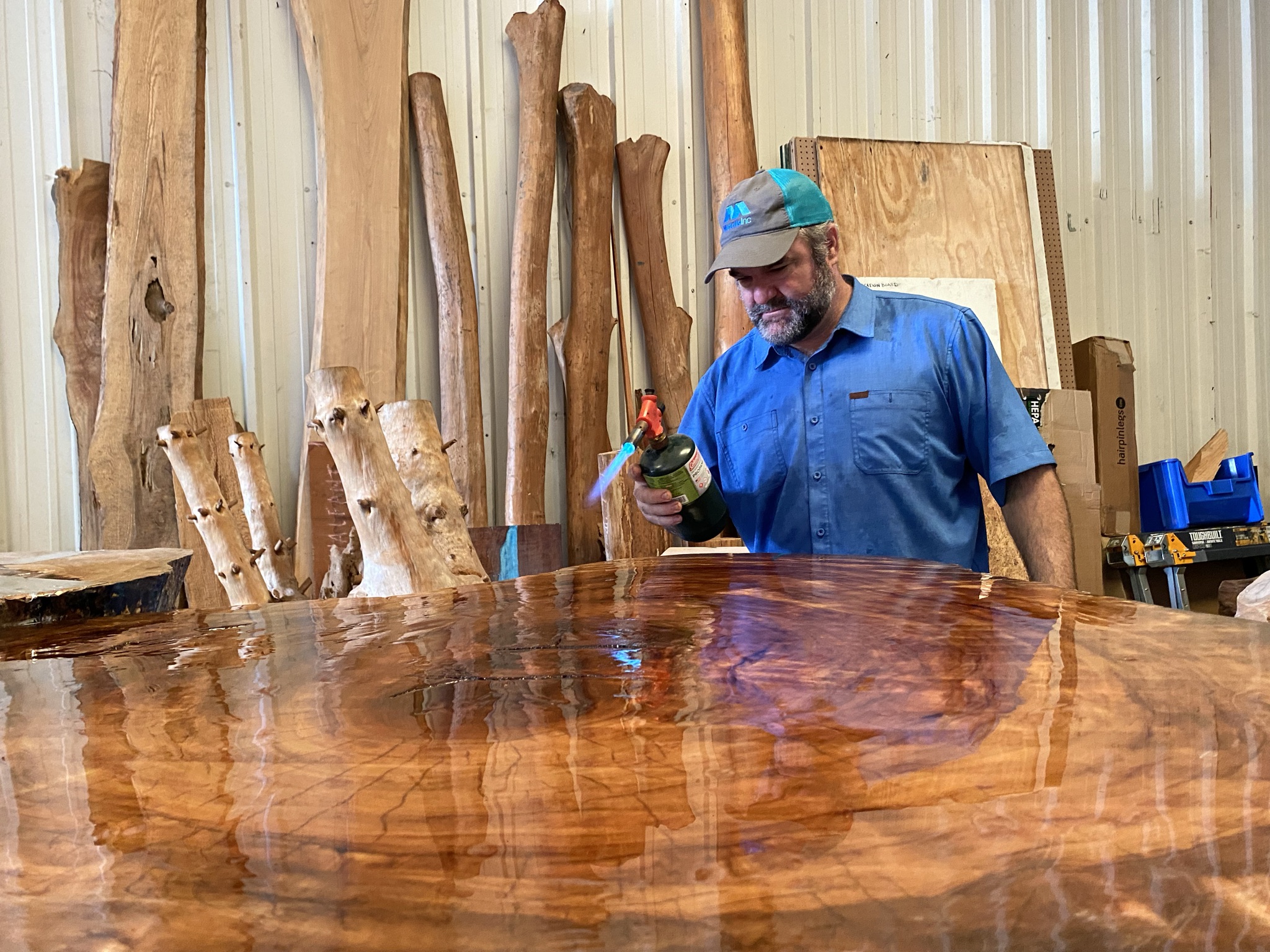1st picture: Ian Orlikoff uses a torch to smooth the epoxy surface of a live edge table at Naples Live Edge Wood.

August 01, 2021By Jeff Lytle
lytle@swspotlight.com
Arborist Ian Orlikoff owned and operated a Naples-based tree service for more than two decades before switching gears to creating custom furnishings. He said he realized he had been “wasting a valuable resource” when trees were cut down and ground up or carted to a landfill.
These days in his hands trees become one-of-a-kind works of art, showcasing the most beautiful and interesting wood grains.
Rather than use wood perfectly milled into straight, smooth lumber, Orlikoff’s tables, chairs and headboards are crafted from slabs that retain the outer or live edge of each tree – from which the “live edge’’ style of woodworking gets its name.
Live edge tables, for example, tend to have curved edges, with or without bark, and even rough, unplaned tops. Some are rubbed with oil. The shiny and often colored surfaces come from poured and hardened liquid plastics.
Orlikoff’s passion has family roots, starting with his father, a woodworker. “I was his manual sander and did everything I could to get away from being recruited into sanding all the time,” he said, reminiscing. “Ironically, now I find sanding is relaxing, therapeutic and I have a connection to my late father. I feel we still share a connection as the wood reveals fine hidden details. We are experiencing it together.”
He went on to share the story of his mother growing up in World War II bomb-riddled Germany. One day, rather than go to a cramped, smelly bomb shelter, “she would run from tree to tree, hugging each to seek its protection amidst the explosions,” he said. “She is in the truest sense a tree hugger. Perhaps this is where my appreciation for trees began because she loves trees so much.”
Orlikoff’s Naples Live Edge Wood, a combination showroom and workshop in an industrial park on Mercantile Avenue near Naples Airport, is full of other stories – in the furniture he makes or slabs of wood he sells to hobbyists.
Beth Franklin of Naples Reserve is tickled that her giant dining room table came from a Port Royal mahogany tree felled by Hurricane Irma. “I have a piece of Naples history in my home,” she said. “I just think that’s cool.”
Orlikoff says his most unusual piece is a bench made from another Irma tree, with limb shear scars intact.
All of the inventory is local. Tree services bring him specimens; he spots interesting shapes and species as he drives around town; or customers bring him samples of mature trees with sentimental value, marking the birth of a child, for example.
“In a way I can offer a memorial service,” he explained. “People are very attached to their trees.”
“Not a single tree has been cut down just to make a piece of furniture in this shop,” Orlikoff said proudly.
Orlikoff is part of something big. The American Hardwood Information Center reported live edge “is an increasingly popular decorative trend in today’s residential interiors.”
Originally designed to recreate a log cabin or western look, the AHIC reported, live edge’s “unfinished natural edges and richly figured knotted surfaces fit perfectly into even the most sophisticated urban interiors.”
Interior designer Kriss Lecocq of Naples concurred. She believes live edge has a universal or organic appeal – “a warm feel.”
“It incorporates into anything,” Lecocq explained. “It can be light and beachy or clean and dark for modern.”
Lecocq went to Orlikoff for a set of floating shelves for a client. She said the shelves actually helped the renovated home sell more quickly. “His work is art,” she said.
Orlikoff relishes teaching about the various kinds of wood in his inventory and how to read planks for lifeline clues. Did a tree have good and bad years from plenty or little rainfall? Did nearby development thin a woodland to affect shade and sunlight? Did a tree suffer damage and trauma?
The answers help customers feel more connected with the results. “That’s the icing,” he said. “People often come to buy furniture, and they leave with a greater appreciation for trees.”
His raw wood inventory includes rosewood, mahogany, cypress, cedar, black acacia, pine, oak and even coconut palm.
“Every piece is different,” he said. “I never get tired looking at it.”
To learn more visit naplesliveedgewood.com

